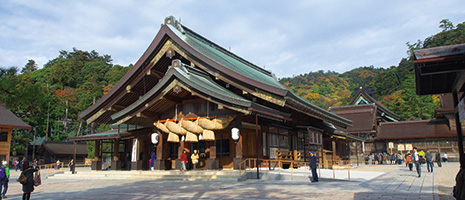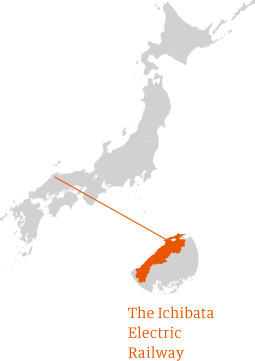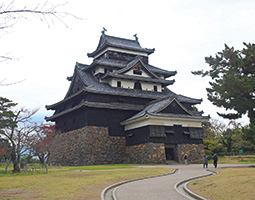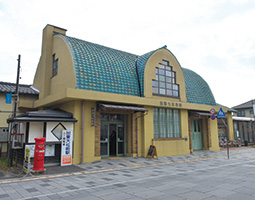Home > Highlighting JAPAN > Highlighting Japan January 2020 > A Trip by Local Train
Highlighting JAPAN


- PREVIOUS
- NEXT
Board the Bataden for Nature and Culture
The Ichibata Electric Railway, known familiarly as the Bataden, connects Izumo City and Matsue City in Shimane Prefecture, taking passengers to local charms including a lake, hot springs, a temple, shrine and castle.
Ichibata Yakushi in Izumo City, Shimane Prefecture is a temple located at the center of Shimane Peninsula, which faces the Japan Sea. It has a history of more than 1,100 years and has attracted many devout worshippers since ancient times. In 1912, a railway operator was founded that transported worshippers to the temple. It is currently operated as Ichibata Electric Railway Co. and has its headquarters in Izumo City. Ichibata Electric Railway operates two lines: the Kita-Matsue Line, which connects Matsue City and Izumo City (33.9 km) between Matsue Shinjiko-onsen Station and Dentetsu Izumoshi Station, and the Taisha Line between Izumotaisha-mae Station and Kawato Station (8.3 km).
The railway lines are both known as the “Bataden” by local people. According to Kato Manabu of Ichibata Electric Railway, the lines are an indispensable means of transportation in the region and highly valued by tourists too, because they provide the opportunity for a nostalgic journey.
One of the features of the Kita-Matsue Line is the view it affords of Lake Shinji. Lake Shinji is oval shaped with a circumference of around 47 kilometers, extending east and west. Passengers can enjoy the view of Lake Shinji from inside the train and from the stations as it travels along the lakeside between Matsue Shinjiko-onsen Station and Sono Station. Lake Shinji is a brackish water lake in which fresh water and seawater are mixed together, and it is abundant with fish and shellfish. In particular, the lake is famous for its freshwater clams, which are the preferred ingredients for miso soup. Fishermen use a long pole with a basket called a joren to scoop the freshwater clams from the bottom of the lake.
Kato says the view of many small fishing boats catching freshwater clams on the glistening lake early in the morning is particularly charming. In winter, he says, beautiful sunsets over Lake Shinji turn the sky and lake surface orange.
Because of the popularity of Instagram in recent years, many tourists visit Lake Shinji to take photos of the view with the sunset, but there are other photo spots that are popular because of their Instagrammability, too. One of these is Awazu Inari shrine, which is about 10 minutes’ walk from Takahama Station on the Taisha Line. The railway track runs between the approach to the shrine, which has twenty shrine gates in a straight line, and the shrine pavilions. Visitors can enjoy the view of a train running between the shrine gates and the shrine pavilions, which is rare in Japan.
Izumotaisha-mae Station is another popular photo spot with tourists. It was opened in 1930 and its station building, which is designated as a registered tangible cultural property, is retro western-style architecture with a semicircular roof. Through the stained-glass windows, bright colors appear on the floor of the station building on sunny days.
Izumo Taisha shrine, which is located 10 minutes’ walk from Izumotaisha-mae Station, is visited by many people throughout the year. Izumo Taisha shrine (formally called Izumo Oyashiro) enshrines O-kuninushi-no-okami, the god of matchmaking, as its main enshrined deity. It has such a long history that its beginning is described in the oldest history books in Japan: Kojiki (compiled in 712) and Nihonshoki (compiled in 720).
A foot spa has been added to Matsue Shinjiko-onsen Station, which faces the northern lakeside of Lake Shinji. Its about a fifteen-minute walk from the station to Matsue Castle. Matsue Castle, which is the symbol of Matsue, was built at the beginning of the Edo period (1603–1867), and its tenshu keep with a history of more than 400 years is designated as a national treasure. A sightseeing boat operates in the moat surrounding Matsue Castle, and tourists can take time to view the castle town, which retains the atmosphere of the Edo period, from the boat .
Furthermore, it is possible to transport bicycles in the cars of the trains of Ichibata Electric Railway on the entire line all day (except when crowded), and bicycles can also be hired at Matsue Shinjiko-onsen Station, Izumotaisha-mae Station and Dentetsu Izumoshi Station.
Kato says that some tourists rent bicycles at Matsue Shinjiko-onsen Station, ride them along Lake Shinji to visit Izumo Taisha shrine, and then return by train.
A one-day pass for the entire line is available. By utilizing both the train and a bicycle, it is possible to enjoy an even more fulfilling journey through the rich natural surroundings and culture of Izumo and Matsue.
- PREVIOUS
- NEXT
© 2009 Cabinet Office, Government of Japan









